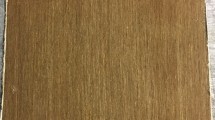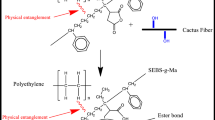Abstract
Recently, investigations have been conducted on the use of natural fibers as reinforcement in low-melting point thermoplastics to improve mechanical properties of composites. However, due to some limitations of natural fibers, composite formulation and processing parameters must be controlled to produce a product with improved properties. This study was conducted to investigate the influence of flax fiber loading, use of compatibilizer and pretreatment on physical and mechanical properties of compression-molded composite. In this study, untreated and treated (sodium hydroxide-treated and mild-bleached flax fibers) fibers at 15% and 30% of the total product mass were used in formulations. To investigate the effect of compatibilizer on product properties, maleic anhydride grafted polypropylene (MAPP) was added at 5% by mass in the formulations. After extrusion of composites formulations, they were formed using compression molding. Results indicated that using flax fiber in composites without pretreatment and compatibilizer could result into products with inferior physical and mechanical properties; this could be compensated by the use of a compatibilizer. However, the use of compatibilizer had some negative effects on some other physical properties like color and melt flow index (MFI).







Similar content being viewed by others
References
Bismarck A, Mishra S, Lampke T (2005) In: Mohanty AK, Misra MM, Drzal LT (eds) Natural fibers, biopolymers, and biocomposites. Taylor & Francis, Boca Raton, FL, pp 37–108
Brouwer WD (2000) Natural fiber composites in structural components: alternative applications for sisal? Paper no. 14. Proceedings of the seminar held by FAO and CFC, Rome, Italy
Nabi Saheb B, Jog JP (1999) Adv Polym Tech 18:351–363
Rowell RM, Tillman AM, Simonson R (1986) J Wood Chem Technol 6:427–448
Bledzki AK, Gassan J (1999) Prog Polym Sci 24:221–274
Karnani R, Krishnan M, Narayan R (1997) Polym Eng Sci 37:476–483
Demir H, Atikler U, Balkose D, Tihminlioglu F (2005) Compos Part A Appl Sci 37:447–456
Hornsby PR, Hinrichsen E, Tarverdi K (1997) J Mater Sci 32:1009–1015
Arbelaiz A, Fernandez B, Cantero G, Llano-Ponte R, Valea A, Mondragon I (2005) Compos Part A Appl Sci 34:1637–1644
Panthapulakkal S, Sain M, Law S (2005) Polym Int 54:137–142
ANKOM Technology (2005) ANKOM Technology Method. http://www.ankom.com/09_procedures/procedures.shtml
ASTM D1238-01 (2003) Standard test method for melt flow rates of thermoplastics by extrusion plastometer, New York
ASTM C518 (2002) Standard test method for steady-state heat flux measurements and thermal transmission properties by means of the heat flow meter apparatus, Philadelphia, PA
Muasher M, Sain M (2006) Polym Degrad Stab 91:1156–1165
ASTM D570 (2003) Standard test method for water absorption of plastics, New York
ASTM D 638-02a (2003) Standard test method for tensile properties of plastics, New York
ASTM D 5023-01 (2001) Standard test methods for plastics: dynamic mechanical properties: in flexure (three-point bending), New York
ASTM D1822-93 (1993) Standard test method for tensile-impact energy to break plastics and electrical insulating materials, Baltimore, MD
Joseph K, Mattoso LHC, Toledo LHC, Thomas S, de Carvalho LH, Pothen L, Kala S, James B (2000) In: Frollini E, Leão AL, Mattoso LHC (eds) Natural polymers and agrofibers composites, Sãn Carlos, Brazil, pp 159–201
Viksne A, Rence L, Kalnins M, Bledzki AK (2004) J Appl Polym Sci 93:2385–2393
Tajvidi M, Ebrahimi G (2003) J Appl Polym Sci 88:941–946
Hargitai H, Racz I (2005) Proceeding of the 8th polymers for advanced technologies international symposium, Budapest, Hungary
Qiu W, Zhang F, Endo T, Hirotsu T (2005) Polym Compos 26:448–453
Feng D, Caulfield DF, Sanadi AR (2001) Polym Compos 22:506–517
Author information
Authors and Affiliations
Corresponding author
Rights and permissions
About this article
Cite this article
Soleimani, M., Tabil, L., Panigrahi, S. et al. The Effect of Fiber Pretreatment and Compatibilizer on Mechanical and Physical Properties of Flax Fiber-Polypropylene Composites. J Polym Environ 16, 74–82 (2008). https://doi.org/10.1007/s10924-008-0102-y
Published:
Issue Date:
DOI: https://doi.org/10.1007/s10924-008-0102-y




